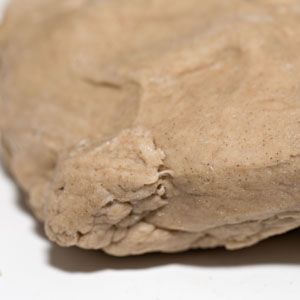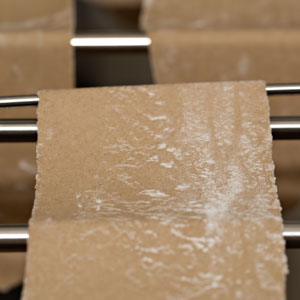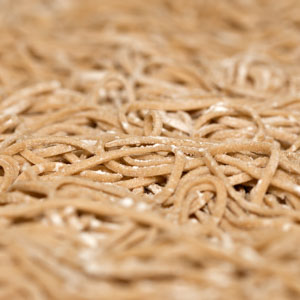Soba

introduction
In Japan, master soba makers trained in their craft from childhood make soba noodles by hand. One hundred percent pure buckwheat noodles are notoriously difficult to fabricate and famously driven to break. The reason: buckwheat flour is weak, lacking the strength given to wheat flour by a protein called gluten. For our own handmade soba, we had to cheat a bit by blending fresh, mountain-grown Japanese buckwheat flour and Farina di Maccheroni ‘00’ Crema, a superfine pasta flour made from wheat, to create Ni-Hachi Sobakoh. With this custom-blended flour, we have managed to reduce soba noodle’s susceptibility to fracture and keep the buckwheat flavor high at the same time.
The noodles themselves conjure herbs, wet earth, and dark, roasted tea.
Cooking Remarks
To make the noodle dough, we use boiling water to gel the starch present in the buckwheat component of our sobakoh (the Japanese term for the flour used to make soba). When this starch is elastic, warm, and hydrated, it interacts with the glutinous properties of the wheat flour in our sobakoh to help create an extensible dough.
The hydration of this dough is sensitive: it can jump from too dry to too wet tout de suite. Any number of factors—your measuring technique, your measuring cups, and the way in which you’ve stored the flour—may necessitate minor adjustments of water or flour once you’ve first mixed the dough. Feel free to make these adjustments, but do so cautiously, as directed in the recipe below. The dough should be as dry as possible without being crumbly.
Soba, which is intended to be eaten fresh, is generally prepared, cooked, and consumed on the same day. Don’t make the noodles too far in advance of serving. If the cooked noodles stick together, gently rinse them in cool water before plating them.
equipment mise en place
For this recipe, you will need a food processor, a teakettle, a heatproof liquid measuring cup, a digital kitchen scale, a quart-size zipper-lock bag, a manual pasta machine, a bench knife or chef's knife, a drying rack (real or improvised—a wooden rack for drying clothes works extremely well and a suspended broom handle will do in a pinch), a rolling pin, a baking sheet, parchment paper, a large stockpot, a pair of tongs, and a colander.
-
-
10ounces (2 cups) Anson Mills Ni-Hachi Sobakoh, plus additional as needed
-
Spring or filtered water
-
1teaspoon fine sea salt
-
-
Place the sobakoh in the food processor bowl. Bring 6 ounces (¾ cup) of spring or filtered water to a boil in a teakettle. Measure the salt into a heatproof liquid measuring cup, set it on a digital kitchen scale, and pour 4 ounces of boiling water into the cup. Swirl to dissolve the salt. With the food processor running, pour the water through the feed tube and process until a dough forms, chases itself around the bowl, and comes together into a ball, about 20 seconds. If, after 20 seconds, the dough remains crumbly, add hot water 1 or 2 drops at a time with the machine running. If the dough feels extremely soft and sticky, add sobakoh by the teaspoon, processing after each addition. The dough should be as dry as possible while still workable.
-
Turn the dough out onto a work surface and knead lightly for a couple of minutes without adding more sobakoh—it should be dryish and have the consistency of smooth, supple, strong pasta dough (fig. 2.1). Flatten the dough into a 6-inch disk and place it in a quart-size zipper-lock bag; do not seal the bag. Let the dough rest for 30 minutes.
-
Set up a manual pasta machine and a drying rack (a suspended broom handle works well). Using a bench knife or chef’s knife, cut the dough into eighths. Cover 7 pieces with plastic wrap, lightly flour the eighth piece, and, with a rolling pin, roll it into a band about 3 inches wide and 6 inches long. Run the dough twice through the second widest setting on the pasta machine, and then twice through the fourth setting, dusting with sobakoh as needed. The band of dough will now be 9 or 10 inches long and 4 inches wide. Hang the dough across the drying rack (fig. 3.1). Repeat this process with the remaining 7 pieces of dough. Let the dough sheets dry for about 30 minutes, turning them occasionally; they should be firm and dry but not frayed at the edges.
-
Set the pasta machine to cut linguine. Line a baking sheet with parchment paper and dust it with sobakoh. Working with one at a time, lightly flour the bands of dough with sobakoh and feed each through the machine. As the noodles are cut, place them on the prepared baking sheet and lightly spread them with your fingers. Once all of the noodles have been cut, allow them to dry, uncovered, for up to 4 hours (fig. 4.1).
-
To cook the soba, in a large stockpot, bring about 4 quarts of water to a boil over high heat. Lift the noodle-bearing parchment up and slide the noodles into the boiling water. After about 10 seconds, gently stir with tongs. Cook until the soba is tender but still firm, 20 to 40 seconds longer, and then drain in a colander set in the sink. Flush with cool water by running the water onto your outstretched hands held over the noodles to protect them. Drain well.
-
-
2.1

-
-
-
3.1

-
-
-
4.1

-